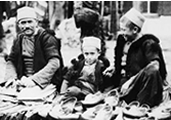| Albania Table of Contents
In 1991 Albania had a birth rate of 24 per 1,000, and its death rate had declined from 14 per 1,000 in 1950 to 5 per 1,000. A concomitant of the reduced death rate was an increase in life expectancy. Official Albanian sources indicated that average life expectancy at birth increased from fifty-three years in 1950 to seventy-two years for males and seventy-nine years for females in 1991. The population was among the most youthful in Europe, with an average age of twenty-seven years, and the fertility rate--2.9 children born per woman--was one of Europe's highest. Albania was the only country in Europe with more males than females. The disparity in the male-to-female ratio, which was 1,055:1,000 in 1970, had increased to the point where males accounted for 51.5 percent of the population in 1990, This discrepancy was attributed in part to a higher mortality rate among female infants, caused by neglect and the traditional deference accorded male progeny. Losses in World War II, estimated by the United Nations at 30,000 persons, or 2.5 percent of the population, apparently had little influence on the ratio of males to females. Ethnicity For more recent population estimates, see Facts about Albania. 
Custom Search
Source: U.S. Library of Congress |
 The average annual growth rate of the Albanian population for the
period 1960-90 was 2.4 percent, or approximately three to four times
higher than that of other European countries. Population growth was
actively encouraged by the government, which deemed it "essential
for the further strengthening and prosperity of socialist society."
Albania had a population of 3,335,000 in July 1991, compared with
2,761,000 in mid-1981 and 1,626,000 in 1960. The most sparsely populated
Balkan country until 1965, Albania attained a population density of 111
inhabitants per square kilometer in 1989--the highest in the Balkans.
The 1991 growth rate was 1.8 percent.
The average annual growth rate of the Albanian population for the
period 1960-90 was 2.4 percent, or approximately three to four times
higher than that of other European countries. Population growth was
actively encouraged by the government, which deemed it "essential
for the further strengthening and prosperity of socialist society."
Albania had a population of 3,335,000 in July 1991, compared with
2,761,000 in mid-1981 and 1,626,000 in 1960. The most sparsely populated
Balkan country until 1965, Albania attained a population density of 111
inhabitants per square kilometer in 1989--the highest in the Balkans.
The 1991 growth rate was 1.8 percent.